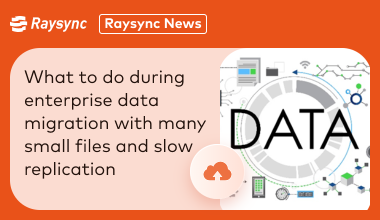What is DCP Transfer and How to Transfer?
December 7, 2023Raysync provides a reliable solution for DCP file transfer.File transfer has become an integral part of business in the digital age. With more and more companies adopting cloud infrastructure and services, efficiently transferring large files and datasets to the cloud and between teams is crucial. This is where DCP (Data Copy Protocol) file transfer comes in.
Part 1: What is DCP File Transfer?
DCP, or Data Copy Protocol, is a method of transferring large files and datasets over long distances. It overcomes issues like packet loss, latency, and transfer interruptions that typically bottleneck default transfer protocols when transferring extremely large files.
DCP utilizes advanced data and transfer scheduling algorithms to provide reliable, fast, and secure transfers up to petabytes in size over global distances. This allows organizations to move big data, large media files, and system backups efficiently.
Unlike default TCP-based transfers that struggle with long distances, DCP optimizes network paths and resources, providing transfers 200 times faster over global networks. Top providers like Raysync reach speeds up to 100Gbps.
DCP also overcomes typical issues like packet loss, latency, and jitter and allows for reliable resuming of interrupted transfers - critical for big file transfers. This makes DCP one of the most reliable protocols specialized in handling large file and big data transfers worldwide between organizations, project teams and cloud storage platforms.
Part 2: Why Has the Need for DCP Transfer Increased?
Multiple driving factors have exponentially increased the need for reliable, high-speed DCP data transfer in recent years:
● Rise of Over-the-Top (OTT) Media Services: Popular streaming services like Netflix, Prime Video, Hulu, etc. rely on moving enormous volumes of film, TV and user-generated content worldwide to deliver services. DCP allows the efficient transfer of these massive media libraries globally.
● Growth of Video-on-Demand and Live Streaming: Surging consumer demand for on-demand and live video content from sports, news, events, etc., requires transferring tremendous volumes of bandwidth-heavy video worldwide. DCP makes this feasible.
● Exponential Increase in Digital Advertising: Digital ad spending expanded 22% to $489 billion in 2022. Rich media ads with heavy video, images and animation depend heavily on DCP for rapid content distribution to digital platforms.
● High-Resolution and Encoded Media: 8K, HDR, and new video codecs have exponentially increased file sizes. This media needs reliable air transport without quality loss, which DCP delivers.
Part 3: What Types of DCP Transfers Are Available?
There are primarily two main types of DCP file transfer solutions:
1. Managed File Transfer Services
Managed file transfer services refer to cloud services that provide DCP-powered secure data transport over the internet, i.e. from user to cloud networks.
Top providers utilize dedicated DCP transport technology constructed on top of cloud infrastructure to deliver reliable turnkey global data transfers without organizations needing any transfer software or hardware themselves.
Benefits include:
● Plug and Play - No transfer software is needed for using service
● Security - Encryption, access control, data isolation etc, built-in
● Reliability - Guaranteed uptime with failover data centers
● Support for Hybrid Cloud - Transfer from on-premise to multiple cloud environments
● Managed file transfer cloud services allow easy DCP transport flexibility without operational complexity - ideal for media companies and collaborative workflows. Both software tools and services provide their unique DCP transfer advantages. Choosing one over the other depends on specific organizational needs. But they both enable fast, reliable movement of mass data.
2. DCP Software Tools
This refers to downloadable software tools that leverage DCP to provide secured, accelerated transfer of large files and datasets locally or to the cloud.
Top tools like Raysync transfer managers utilize innovative DCP transfer technology to offer unmatched transfer speeds, intelligent data management, and reliability.
Other features include:
● Secure Encryption - Bank-level AES-256 encryption
● Transfers Up to 100Gbps - Up to 200 times faster transfers
● Interruption Recovery - Resume from any unexpected stops
● Data Integrity Verification - 100% accurate transfers
DCP software tools give users full control over managing secure, accelerated large data movement from one location to another.
Part 4: How to use Raysync to transfer DCP files?
Now that we know the capabilities of Raysync in efficient and super-fast large file transfer, let's quickly look at the steps to use Raysync to transfer large files:
Step 1: Contact Raysync sales for installation package and license.
Step 2: Deploy the server and firewall, log in to the admin portal to create a user account.
Step 3: Login to the user side to download the client.
Step 4: High-speed upload and download.
If you have more questions about using it, click to view the link below:https://www.raysync.io/support/document/product/start-deployment
Conclusion
DCP, or Data Copy Protocol, has become the go-to method for securely transferring large volumes of data across vast distances. With growing dependence on data and the adoption of cloud infrastructure, efficiently transferring files and datasets globally is now mission-critical for organizations. Raysync, a large file transfer solution provider, offers efficient file transfer services for dcp file transfer in the film and media industry.
You might also like

Raysync News
June 22, 2020With the development of the Internet, it is a very common thing to transfer large and small files in the daily office.

Raysync News
December 26, 2023UDP packet loss affects the quality and efficiency of transmission, causing data loss, delay, and even transmission failure. So, this article will analyze the reasons for UDP packet loss and the corresponding common solutions for reference.

Raysync News
February 2, 2024How to migrate and transfer a large number of small files efficiently. These small files on the server, although individually small in size, are often very slow to replicate during the migration process.